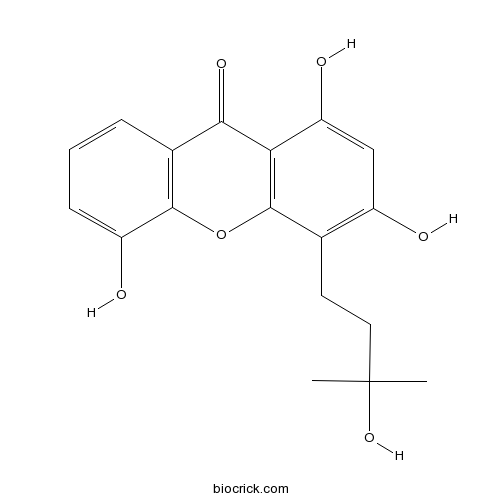1,3,5-Trihydroxy-4-(3-hydroxy-3-methylbutyl)xanthoneCAS# 299895-11-7 |

Quality Control & MSDS
3D structure
Package In Stock
Number of papers citing our products

| Cas No. | 299895-11-7 | SDF | Download SDF |
| PubChem ID | 10806296 | Appearance | Yellow powder |
| Formula | C18H18O6 | M.Wt | 330.3 |
| Type of Compound | Xanthones | Storage | Desiccate at -20°C |
| Solubility | Soluble in Chloroform,Dichloromethane,Ethyl Acetate,DMSO,Acetone,etc. | ||
| Chemical Name | 1,3,5-trihydroxy-4-(3-hydroxy-3-methylbutyl)xanthen-9-one | ||
| SMILES | CC(C)(CCC1=C(C=C(C2=C1OC3=C(C2=O)C=CC=C3O)O)O)O | ||
| Standard InChIKey | BVFVSOVOONXBEC-UHFFFAOYSA-N | ||
| General tips | For obtaining a higher solubility , please warm the tube at 37 ℃ and shake it in the ultrasonic bath for a while.Stock solution can be stored below -20℃ for several months. We recommend that you prepare and use the solution on the same day. However, if the test schedule requires, the stock solutions can be prepared in advance, and the stock solution must be sealed and stored below -20℃. In general, the stock solution can be kept for several months. Before use, we recommend that you leave the vial at room temperature for at least an hour before opening it. |
||
| About Packaging | 1. The packaging of the product may be reversed during transportation, cause the high purity compounds to adhere to the neck or cap of the vial.Take the vail out of its packaging and shake gently until the compounds fall to the bottom of the vial. 2. For liquid products, please centrifuge at 500xg to gather the liquid to the bottom of the vial. 3. Try to avoid loss or contamination during the experiment. |
||
| Shipping Condition | Packaging according to customer requirements(5mg, 10mg, 20mg and more). Ship via FedEx, DHL, UPS, EMS or other couriers with RT, or blue ice upon request. | ||
| Description | 1,3,5-Trihydroxy-4-(3-hydroxy-3-methylbutyl)xanthone is a natural product from Cudrania cochinchinensis. |
| In vitro | Studies on the constituents of Anaxagorea luzonensis A. GRAY.[Pubmed: 10959592]Chem Pharm Bull (Tokyo). 2000 Aug;48(8):1219-22.
|
| Structure Identification | J Asian Nat Prod Res. 2007 Apr-Aug;9(3-5):393-7.Xanthones from the roots of Cudrania fruticosa Wight.[Pubmed: 17613626 ]
|

1,3,5-Trihydroxy-4-(3-hydroxy-3-methylbutyl)xanthone Dilution Calculator

1,3,5-Trihydroxy-4-(3-hydroxy-3-methylbutyl)xanthone Molarity Calculator
| 1 mg | 5 mg | 10 mg | 20 mg | 25 mg | |
| 1 mM | 3.0276 mL | 15.1378 mL | 30.2755 mL | 60.551 mL | 75.6888 mL |
| 5 mM | 0.6055 mL | 3.0276 mL | 6.0551 mL | 12.1102 mL | 15.1378 mL |
| 10 mM | 0.3028 mL | 1.5138 mL | 3.0276 mL | 6.0551 mL | 7.5689 mL |
| 50 mM | 0.0606 mL | 0.3028 mL | 0.6055 mL | 1.211 mL | 1.5138 mL |
| 100 mM | 0.0303 mL | 0.1514 mL | 0.3028 mL | 0.6055 mL | 0.7569 mL |
| * Note: If you are in the process of experiment, it's necessary to make the dilution ratios of the samples. The dilution data above is only for reference. Normally, it's can get a better solubility within lower of Concentrations. | |||||

Calcutta University

University of Minnesota

University of Maryland School of Medicine

University of Illinois at Chicago

The Ohio State University

University of Zurich

Harvard University

Colorado State University

Auburn University

Yale University

Worcester Polytechnic Institute

Washington State University

Stanford University

University of Leipzig

Universidade da Beira Interior

The Institute of Cancer Research

Heidelberg University

University of Amsterdam

University of Auckland

TsingHua University

The University of Michigan

Miami University

DRURY University

Jilin University

Fudan University

Wuhan University

Sun Yat-sen University

Universite de Paris

Deemed University

Auckland University

The University of Tokyo

Korea University
- NKY 80
Catalog No.:BCC8003
CAS No.:299442-43-6
- NPS ALX Compound 4a dihydrochloride
Catalog No.:BCC7629
CAS No.:299433-10-6
- 5,6-Dimethyl-2-Benzothiazolamine
Catalog No.:BCC8723
CAS No.:29927-08-0
- Ro 20-1724
Catalog No.:BCC6638
CAS No.:29925-17-5
- 7-Hydroxy-6-methoxy-3-prenylcoumarin
Catalog No.:BCN5207
CAS No.:299159-90-3
- Eledoisin-Related Peptide
Catalog No.:BCC5849
CAS No.:2990-43-4
- Sparteine sulfate pentahydrate
Catalog No.:BCN1267
CAS No.:299-39-8
- Astringin
Catalog No.:BCN3412
CAS No.:29884-49-9
- Amygdalin
Catalog No.:BCN5206
CAS No.:29883-15-6
- Ro 67-7476
Catalog No.:BCC6145
CAS No.:298690-60-5
- Pirenzepine dihydrochloride
Catalog No.:BCC6923
CAS No.:29868-97-1
- Astilbin
Catalog No.:BCN5204
CAS No.:29838-67-3
- YM 202074
Catalog No.:BCC7682
CAS No.:299900-84-8
- Arecoline hydrobromide
Catalog No.:BCN2913
CAS No.:300-08-3
- H-Tyr(3,5-I2)-OH
Catalog No.:BCC3263
CAS No.:300-39-0
- Hypotaurine
Catalog No.:BCN1749
CAS No.:300-84-5
- Isoline
Catalog No.:BCN2063
CAS No.:30000-36-3
- HEAT hydrochloride
Catalog No.:BCC6683
CAS No.:30007-39-7
- Diphyllin O-glucoside
Catalog No.:BCN8065
CAS No.:30021-77-3
- Ro 28-1675
Catalog No.:BCC4124
CAS No.:300353-13-3
- Boc-Asn-ol
Catalog No.:BCC2587
CAS No.:30044-67-8
- Dehydrocorydalin
Catalog No.:BCN2474
CAS No.:30045-16-0
- SKF 77434 hydrobromide
Catalog No.:BCC7144
CAS No.:300561-58-4
- HMBA Linker
Catalog No.:BCC2831
CAS No.:3006-96-0
Xanthones from the roots of Cudrania fruticosa Wight.[Pubmed:17613626]
J Asian Nat Prod Res. 2007 Apr-Aug;9(3-5):393-7.
Chemical investigation on the roots of Cudrania fruticosa resulted in the isolation of two new xanthones, 1,6,7-trihydroxy-2-(1,1-dimethyl-2-propenyl)-3-methoxyxanthone (1) and 3,6,7-trihydroxy-1-methoxyxanthone (2), together with three known ones, 1,3,5-Trihydroxy-4-(3-hydroxy-3-methylbutyl)xanthone (3), 1,3-dihydroxy-6,7-dimethoxyxanthone (4) and 3,5,6-trihydroxy-1-methoxyxanthone (5), respectively. Their structures were elucidated on the basis of spectral and chemical techniques.
Studies on the constituents of Anaxagorea luzonensis A. GRAY.[Pubmed:10959592]
Chem Pharm Bull (Tokyo). 2000 Aug;48(8):1219-22.
Five new xanthones, 1,3,6-trihydroxy-5-methoxy-4-prenylxanthone (1), 1,3,5-trihydroxy-6-methoxy-2-prenylxanthone (2), 1,3,5-trihydroxy-4-(3-hydroxy-3-methylbutyl) xanthone (3), 1,3,6-trihydroxy-4-prenylxanthone (4), 3,6-dihydroxy-1,5-dimethoxyxanthone (5) and one new flavonoid, 3,5,7,4'-tetrahydroxy-2'-methoxyflavone (6) along with seven known xanthones and seven known flavonoids were isolated from the bark of Anaxagorea luzonensis A. GRAY and their chemical structures were determined by means of chemical and spectral studies. Almost all flavonoids and one xanthone (13) showed antioxidant activity.


